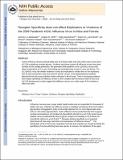Receptor specificity does not affect replication or virulence of the 2009 pandemic H1N1 influenza virus in mice and ferrets
Author(s)
Lakdawala, Seema S.; Shih, Angela R.; Jayaraman, Akila; Lamirande, Elaine W.; Moore, Ian; Paskel, Myeisha; Sasisekharan, Ram; Subbarao, Kanta; ... Show more Show less
DownloadReceptor Specificity.pdf (1.438Mb)
PUBLISHER_CC
Publisher with Creative Commons License
Creative Commons Attribution
Terms of use
Metadata
Show full item recordAbstract
Human influenza viruses predominantly bind α2,6 linked sialic acid (SA) while avian viruses bind α2,3 SA-containing complex glycans. Virulence and tissue tropism of influenza viruses have been ascribed to this binding preference. We generated 2009 pandemic H1N1 (pH1N1) viruses with either predominant α2,3 or α2,6 SA binding and evaluated these viruses in mice and ferrets. The α2,3 pH1N1 virus had similar virulence in mice and replicated to similar titers in the respiratory tract of mice and ferrets as the α2,6 and WT pH1N1 viruses. Immunohistochemical analysis determined that all viruses infected similar cell types in ferret lungs. There is increasing evidence that receptor specificity of influenza viruses is more complex than the binary model of α2,6 and α2,3 SA binding and our data suggest that influenza viruses use a wide range of SA moieties to infect host cells.
Date issued
2013-09Department
Massachusetts Institute of Technology. Department of Biological Engineering; Koch Institute for Integrative Cancer Research at MITJournal
Virology
Publisher
Elsevier
Citation
Lakdawala, Seema S., Angela R. Shih, Akila Jayaraman, Elaine W. Lamirande, Ian Moore, Myeisha Paskel, Ram Sasisekharan, and Kanta Subbarao. “Receptor Specificity Does Not Affect Replication or Virulence of the 2009 Pandemic H1N1 Influenza Virus in Mice and Ferrets.” Virology 446, no. 1–2 (November 2013): 349–356.
Version: Author's final manuscript
ISSN
00426822
1096-0341